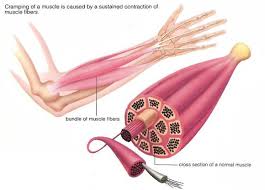A muscle cramp is an involuntarily and forcibly contracted muscle that does not relax. When we use the muscle that can be controlled voluntarily, such as those of our arms and legs, they alternately contract and relax as we move our limbs. Muscle that support our head, neck, and trunk contract similarly in a synchronized fashion to maintain our posture. A muscle (or even a few fibers of a muscle) that involuntarily ( without consciously willing it0 contracts is in a "spasm". If the spam is forceful and sustained, it become a cramp. Muscle cramp cause a visible or palpable hardening of the involved.

Muscle cramps can last anywhere from a few seconds to a quarter of an hour or occasionally longer. It is not uncommon for a camp to recur multiple times until it finally goes away. the cramp may involve a part of a muscle, the entire muscle, or several muscles that usually act together, such as those that flex adjacent fingers. Some cramps involve the simultaneous contraction of muscles that ordinarily move body parts in opposite directions.
Cramps can extremely common. Almost everyone ( one estimate is about 95%) experience a cramp at some time in their life. Cramps are common in adults and become increasingly frequent with aging. However, children also experience cramps.
Any of the muscles that are under our voluntary control (skeletal muscles) can cramp. Cramps of the extremities, especially the legs and feet, and most particularly the calf (the classic "charley horse"), are very common. Involuntary muscles of the various organs (uterus, blood vessel wall, bowels, bile and urine passages, bronchial tree, etc.) are also subjects to cramps.


Muscle cramps can last anywhere from a few seconds to a quarter of an hour or occasionally longer. It is not uncommon for a camp to recur multiple times until it finally goes away. the cramp may involve a part of a muscle, the entire muscle, or several muscles that usually act together, such as those that flex adjacent fingers. Some cramps involve the simultaneous contraction of muscles that ordinarily move body parts in opposite directions.
Cramps can extremely common. Almost everyone ( one estimate is about 95%) experience a cramp at some time in their life. Cramps are common in adults and become increasingly frequent with aging. However, children also experience cramps.
Any of the muscles that are under our voluntary control (skeletal muscles) can cramp. Cramps of the extremities, especially the legs and feet, and most particularly the calf (the classic "charley horse"), are very common. Involuntary muscles of the various organs (uterus, blood vessel wall, bowels, bile and urine passages, bronchial tree, etc.) are also subjects to cramps.
No comments:
Post a Comment